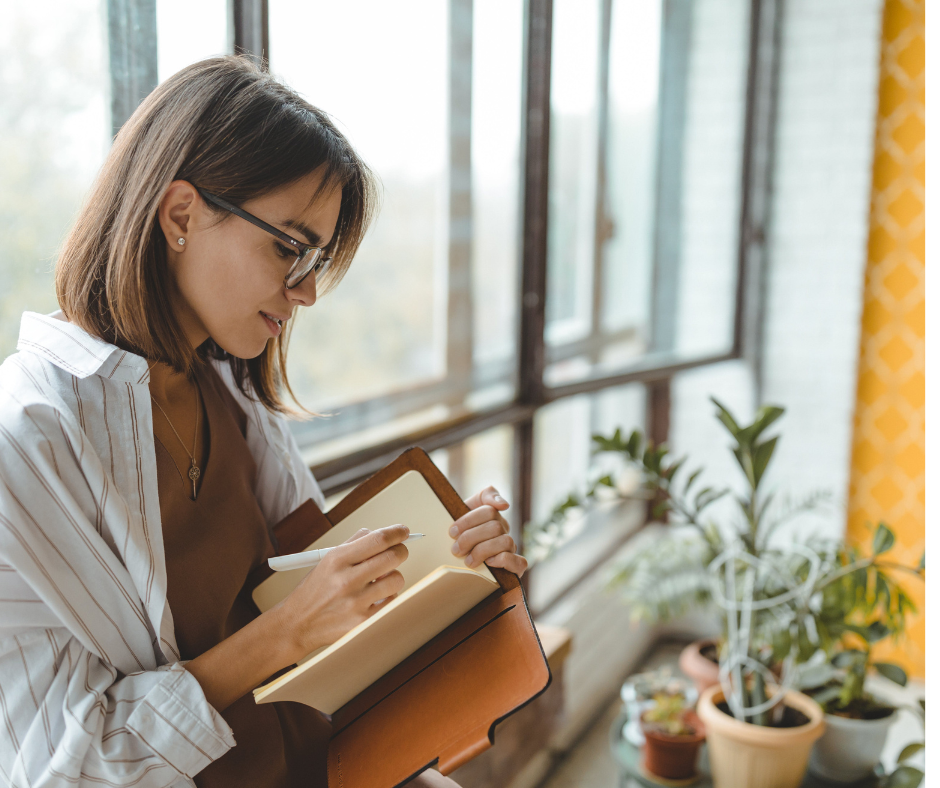We live fast and think faster. Our minds jump from task to task, app to app, fear to fear. When we move at that speed, presence slips away. We miss the simple colors of the day. We skim our feelings and numb our intuition. Intrusive thoughts grow louder because we do not pause long enough to notice them and let them pass.
Slowing down is not a luxury for creatives and dreamers. It is maintenance. Journaling is one of the most effective ways to do this. A pen and page create space for clarity, presence, and gratitude. Words anchor our attention, reveal patterns, and give us a reliable way back to the moment.
Why Journaling Brings Us Back to the Present
Journaling slows racing thoughts and organizes emotions through our words. It clears mental clutter and creates room for intentional action. Over time, it reshapes our inner dialogue. We become less reactive and more grounded in the moment. We begin to see details we once missed.
This practice also deepens gratitude. When we capture small wins, the mind starts to scan for more of them. When we reflect on challenges, lessons become easier to spot. The page turns ordinary days into meaningful stories. With each entry, we demonstrate that presence is available, even in the midst of chaos.
Journaling as a Daily Mindful Pause
Presence is a skill, and journaling is one of the simplest ways to practice it. Like meditation, it asks for only a few minutes and a notebook. Each entry is a pause that allows us to connect with our body, our surroundings, and our emotions. These short pauses build resilience and reduce the pull of distraction.
When we write consistently, gratitude expands, stress softens, and creativity feels lighter. The practice does not need perfect grammar or long passages. It requires only honesty and attention. That is enough to slow down and begin again.
Journaling Prompts to Slow Down Your Mind
Journaling becomes more effective when guided by prompts that bring focus and clarity. Instead of staring at a blank page, use simple questions and frameworks to anchor yourself in the moment. Each of the prompts below is designed to help you pause, notice, and return to the present. They take only a few minutes yet create lasting impact.
1) “Senses Check-In”
How to Use it: Open your journal and name what you notice through each sense. Sight, sound, touch, smell, and taste. Write one to three lines for each reason. Describe the details from where you are right now. Keep it concrete and neutral.
Why it Slows You Down: Describing sensory details sets a gentle anchor in the present. It interrupts mental time travel. Your brain shifts from abstract worrying to direct perception. Attention lands in your body and your space. That shift calms the nervous system and helps you slow down.
Benefits You Can Expect: You build a quick path back to presence during stressful moments. You strengthen focus for creative work because your attention holds one thing at a time. You also train your mind to notice beauty in ordinary scenes. Over days and weeks, slowing down this way makes life feel richer without needing more inputs.
2) “One Page of Now”
How to Use It: Set a timer for 5-10 minutes. Fill one page describing only what is happening at this moment. Write about your posture, breath, mood, and current task. If a thought drifts to the past or future, steer back with a simple line like “Right now, I am…” Keep your language plain and specific.
Why it Slows You Down: A single page creates a clear container. The timer prevents overthinking. Presence becomes a target with a boundary. The mind relaxes because it knows the practice will soon come to an end. This factor reduces avoidance and builds consistency.
Benefits You Can Expect: You cultivate steady awareness during times of transition. You reduce decision fatigue by moving from observation to the following action. You sharpen your storytelling by learning to write concrete scenes rather than vague summaries. That skill carries into captions, blogs, and scripts. When you slow down enough to notice detail, your writing and creativity both improve.
3) “Gratitude in Three Frames”
How to Use it: List three things you appreciate from today and describe each in two sentences. Focus on small, specific moments. A warm mug in your hands. A kind message from a friend. A quiet minute between meetings. End each entry with the impact on your mood or energy.
Why it Slows You Down: Gratitude narrows attention to what is working now. It reduces the urge to chase the next fix. It balances the brain’s bias toward scanning for threats. You return to the enoughness of this moment. Slowing down with gratitude makes the present feel more abundant.
Benefits You Can Expect: You experience more calm and less comparison. You notice energy renewing faster after setbacks. You prime your mind to look for supportive details during the day. This factor improves creativity because ease replaces pressure as your fuel. Gratitude allows us to slow down and see that we already have what we need.
How Journaling Has Benefited Me Since 2020
I began consistent journaling in 2020 during a season of rapid change. I needed a reliable way to process uncertainty and protect my creativity. What started as brief daily entries evolved into a steady ritual that reshaped how I navigated life.
Journaling helped me slow down more often. Short check-ins pulled me out of spirals and back into reality. I recognized intrusive thoughts sooner, named them without judgment, and returned to what mattered.
It also expanded my gratitude. I started to notice how many meaningful moments were already here. Small progress felt worth celebrating, and slowing down showed me joy in ordinary details.
Finally, my storytelling sharpened. Observing daily life trained me to catch details and write scenes instead of vague feelings. That habit improved my creative work and made my words feel closer to the reader.
These benefits came slowly but reliably. I did not need long sessions. Five to fifteen minutes, most days, can build lasting change. Journaling became the most straightforward way for me to slow down and begin again.
Journals I Recommend for You
The right notebook helps you show up with ease. Select a format that aligns with your routine and tools. Below are three solid options that support mindful, present-focused journaling. Each one is easy to use and durable for daily practice.
- The Five Minute Journal by Intelligent Change: A guided option with short morning and evening prompts that make presence simple. Ideal for structure and quick reflection.
- PAPERAGE Lined Journal Notebook: A clean, flexible notebook with an elastic closure and bookmark ribbon. Perfect for freewriting and daily logs.
- LEUCHTTURM1917 Medium A5 Dotted Hardcover: A dotted layout that has numbered pages and a table of contents. Great for bullet journaling and sensory logs.
Select the one that suits your style. What matters most is that it feels inviting. A journal you enjoy makes it easier to slow down and write daily.
Slowing Down Together
Presence changes everything. Creative lives are made from quiet, steady moments. Journaling is a way to notice more, move more slowly, and write with clarity. At Worthiii, we share prompts, reflections, and tools that support this practice. Together, we can slow down, reflect with gratitude, and tell better stories because we live them fully.



